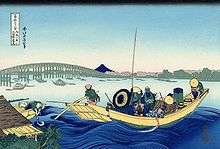Manji (era)
| History of Japan |
|---|
 |
Manji (万治) was a Japanese era name (年号, nengō,, lit. "year name") after Meireki and before Kanbun. This period spanned the years from July 1658 through April 1661.[1] The reigning emperor was Go-Sai-tennō (後西天皇).[2]
Change of era
- 1658 Manji gannen (万治元年): The era name was changed to mark a disastrous, great fire in Edo. The previous era ended and a new one commenced in Meireki 4, on the 23rd day of the 7th month 23rd.
The source of this era name comes from the Records of the Grand Historian: "When the common people know their place, then all under heaven is ruled" (衆民乃定、万国為治)
Events of the Manji era
- 1658 (Manji 1): In the aftermath of the Great Mereiki Fire, the shogunate organized four all-samurai, all-Edo firefighting squads.[3]
- 1658 (Manji 1): Yanagisawa Yoshiyasu is born. Yoshiyasu will become Shogun Tsunayoshi's favorite courtier and chief counselor.[4]
- 1659 (Manji 2): In Edo, construction begins on the Ryōgoku Bridge (ryogokubashi).[2]
- 1660 (Manji 3): Former rojū Sakai Tadakatsu entered the Buddhist priesthood.
Gallery
Notes
- ↑ Nussbaum, Louis-Frédéric. (2005). "Manji" in Japan encyclopedia, p. 607; n.b., Louis-Frédéric is pseudonym of Louis-Frédéric Nussbaum, see Deutsche Nationalbibliothek Authority File.
- 1 2 Titsingh, Isaac. (1834). Annales des empereurs du japon, p. 413.
- ↑ McClain, James et al. (1994). Edo and Paris: Urban Life and the State in the Early Modern Era, p. xxii.
- ↑ Bodart-Bailey, Beatrice. (2006). The Dog Shogun: The Personality and Policies of Tokugawa Tsunayoshi, p. 110.
See also
References
- Bodart-Bailey, Beatrice. (2006). The Dog Shogun: The Personality and Policies of Tokugawa Tsunayoshi. Honolulu: University of Hawaii Press. ISBN 9780824829780; ISBN 9780824830304; OCLC 470123491
- McClain, James L., John M. Merriman and Kaoru Ugawa. (1994). Edo and Paris: Urban Life and the State in the Early Modern Era. Ithaca: Cornell University Press. ISBN 0-8014-8183-X
- Nussbaum, Louis Frédéric and Käthe Roth. (2005). Japan Encyclopedia. Cambridge: Harvard University Press. ISBN 978-0-674-01753-5; OCLC 48943301
- Screech, Timon. (2006). Secret Memoirs of the Shoguns: Isaac Titsingh and Japan, 1779-1822. London: RoutledgeCurzon. ISBN 978-0-203-09985-8; OCLC 65177072
- Titsingh, Isaac. (1834). Nihon Odai Ichiran; ou, Annales des empereurs du Japon. Paris: Royal Asiatic Society, Oriental Translation Fund of Great Britain and Ireland. OCLC 5850691
External links
- National Diet Library, "The Japanese Calendar" -- historical overview plus illustrative images from library's collection
| Preceded by Meireki |
Era or nengō Manji 1658–1661 |
Succeeded by Kanbun |
This article is issued from Wikipedia - version of the 10/4/2016. The text is available under the Creative Commons Attribution/Share Alike but additional terms may apply for the media files.
